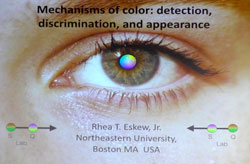 Recently, Prof. Rhea Eskew gave the prestigious “Palmer Lecture” in a presentation entitled, “Mechanisms of Color: Detection, Discrimination, and Appearance,” to the Colour Group of Great Britain as part of their January Meeting. The talk was on the nature, and number, of visual pathways that represent information about color. This was work primarily done by Prof. Eskew’s recent PhD student, Tim Shepard (now a postdoctoral fellow at The Ohio State College of Optometry), along with some very talented NU undergraduates (some of whom have graduated): Comfrey McCarthy, Emily Swanson, and Safiya Lahlaf. They studied color detection, color matching, and color discrimination, in the same conditions in the same subjects, and demonstrated that exactly six — no more, no less — color ‘mechanisms’ could account for the large dataset. These six mechanisms signal red, green, yellow, blue, orange, and purple, loosely speaking.
Recently, Prof. Rhea Eskew gave the prestigious “Palmer Lecture” in a presentation entitled, “Mechanisms of Color: Detection, Discrimination, and Appearance,” to the Colour Group of Great Britain as part of their January Meeting. The talk was on the nature, and number, of visual pathways that represent information about color. This was work primarily done by Prof. Eskew’s recent PhD student, Tim Shepard (now a postdoctoral fellow at The Ohio State College of Optometry), along with some very talented NU undergraduates (some of whom have graduated): Comfrey McCarthy, Emily Swanson, and Safiya Lahlaf. They studied color detection, color matching, and color discrimination, in the same conditions in the same subjects, and demonstrated that exactly six — no more, no less — color ‘mechanisms’ could account for the large dataset. These six mechanisms signal red, green, yellow, blue, orange, and purple, loosely speaking.
The talk was given to an audience of scientists, visual clinicians, and a few industrial and artistic color professionals, (including a fashion professional specializing in guessing which color is going to be hot in the upcoming season).
The Colour Group of Great Britain, founded in 1940, is an interdisciplinary society concerned with all aspects of color, such as its measurement, perception, reproduction, and artistic expression. Monthly meetings and an annual exhibition are held, usually in London, and provide a unique forum for the exchange of information and contacts.
To learn more about Prof. Eskew’s talk and the Colour Group, visit their website here. Congratulations Prof. Eskew on giving this prestigious lecture!
